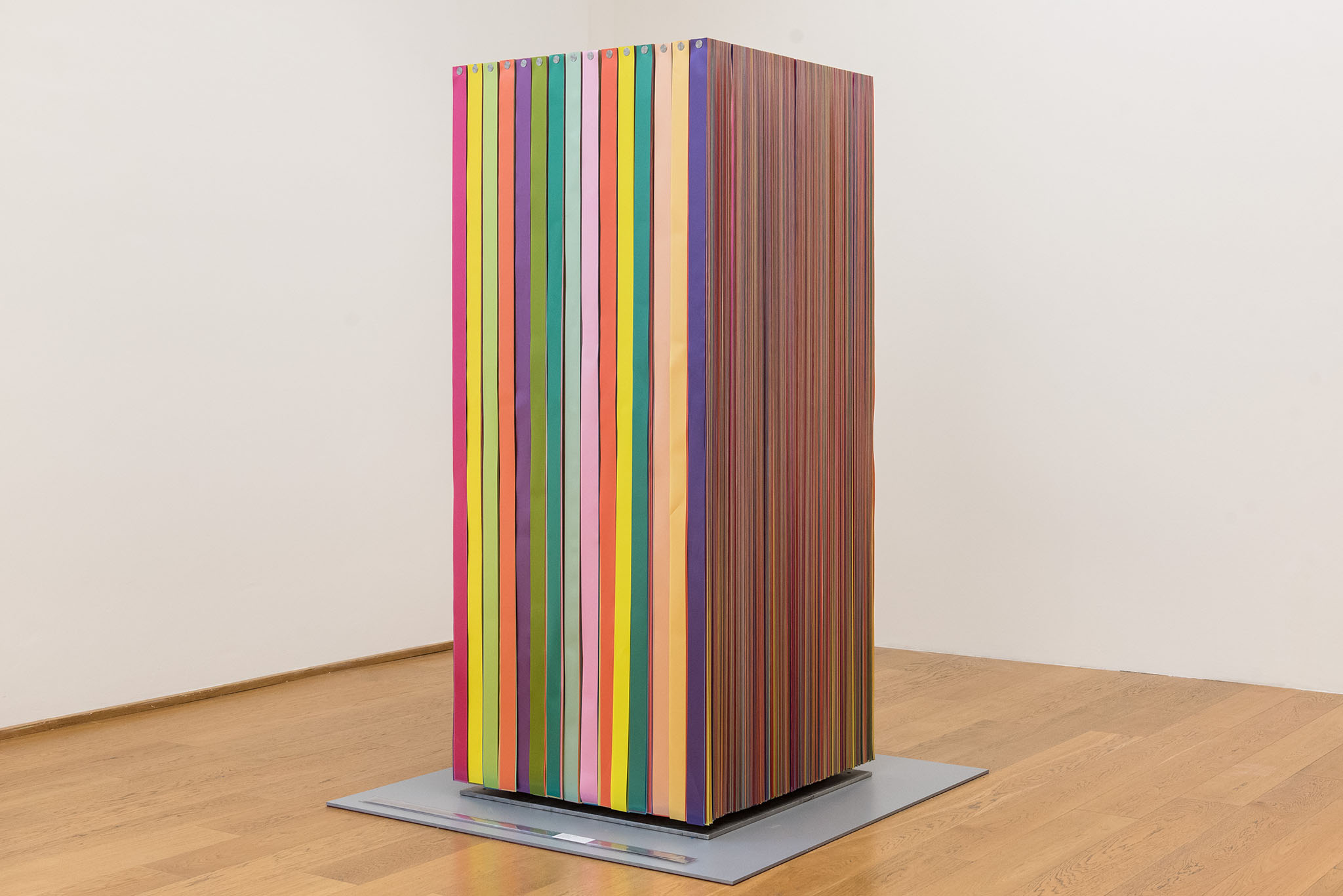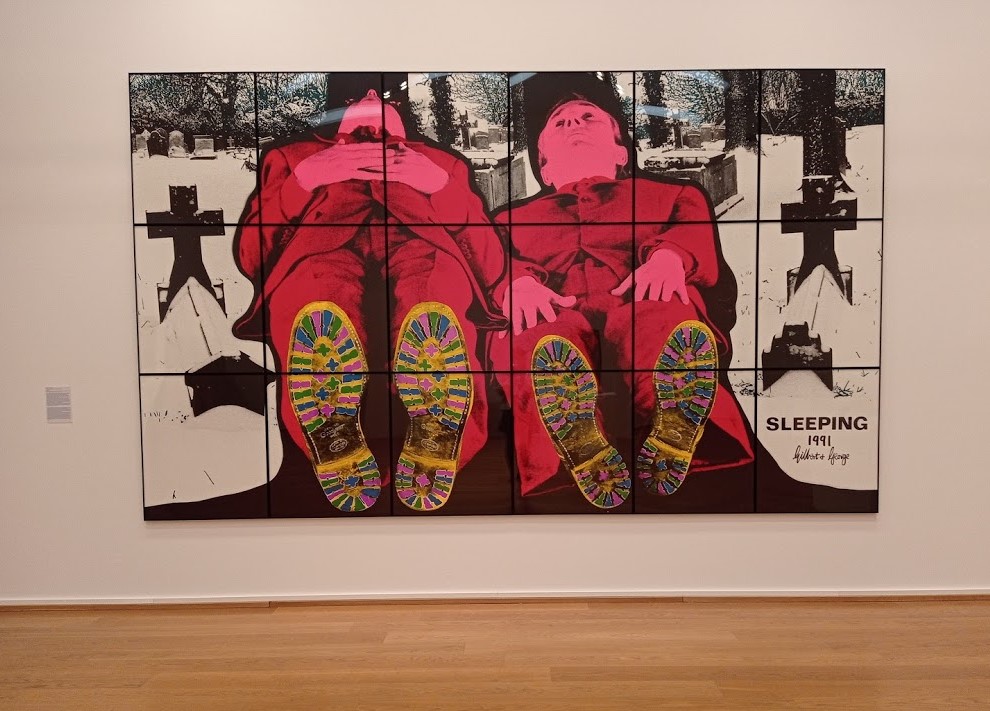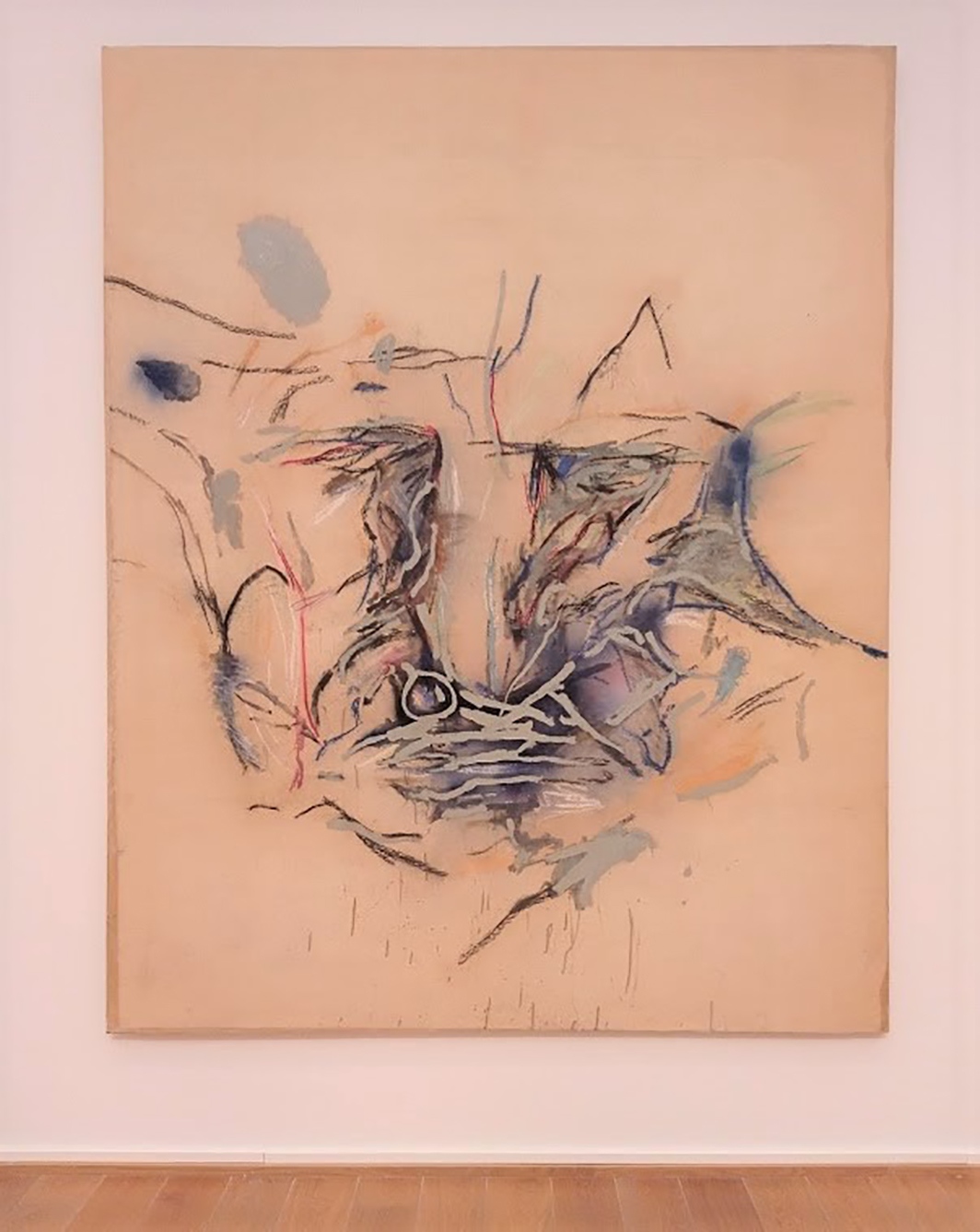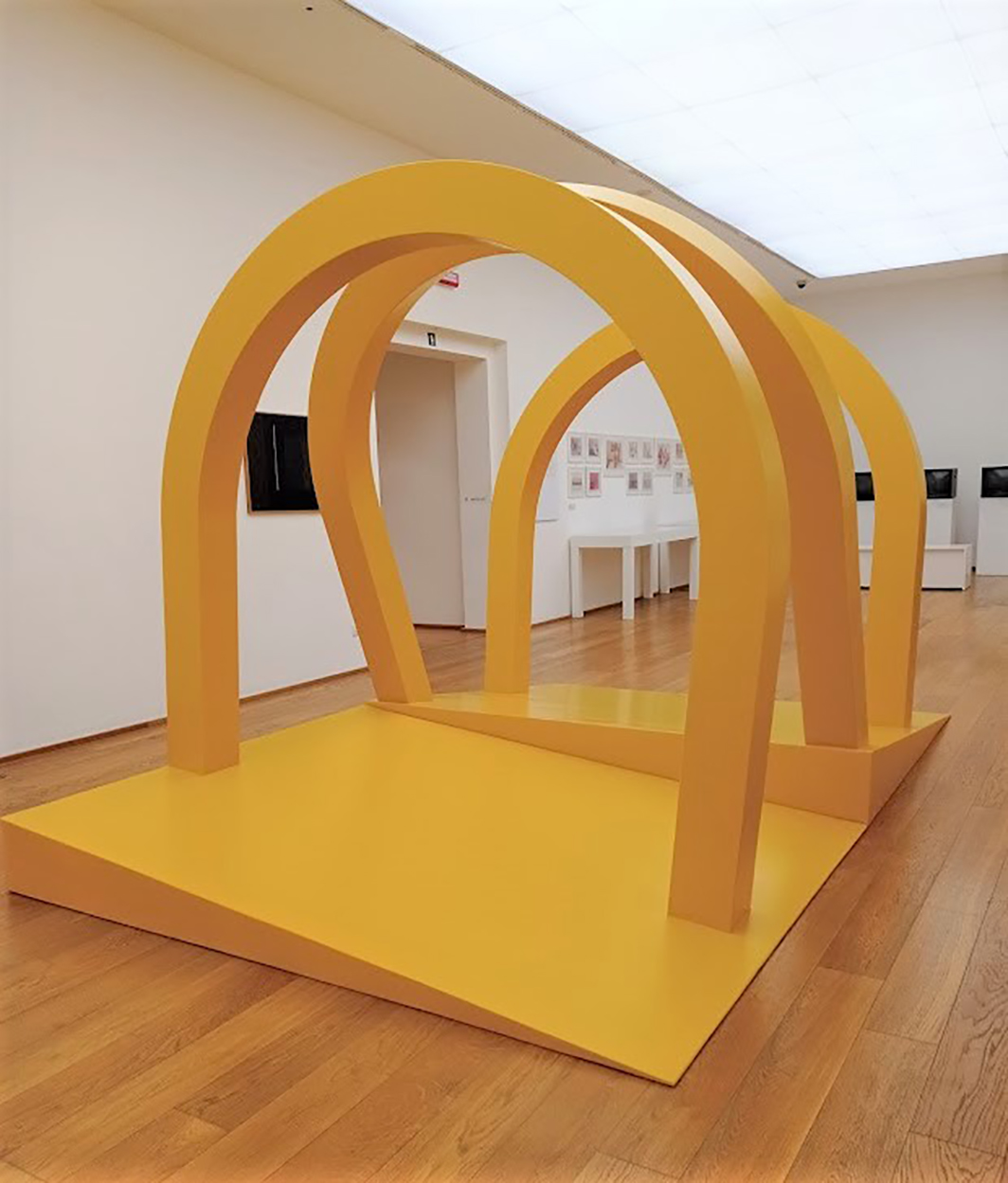MAMbo
This is a fictional text about Hedda who goes to visit MAMbo’s permanent collection for the first time. Hedda feels that she doesn’t understand contemporary art though would like to. In the text we follow her thoughts and associations as she walks around the museum’s collection.
Written during the workshop Art Writing Today: Sulle tracce di Carla Lonzi held by Allison Grimaldi Donahue (ABA Bologna and MAMbo, 2020-2021).

Paola Pivi, I am a rainbow too, 2004, colored ribbons, metal, 196 x 80 cm. MAMbo – Museo d’Arte Moderna di Bologna.
It was a Tuesday in the middle of October 2020 when the museums were still open for visitors, before they closed again during this strange year. Hedda was free from work that morning and to get out, see people and something different from the inside of her apartment and her computer screen, she decided to go to MAMbo, the Museum of Modern Art in Bologna, to get some stimulus.
She went down the stairs and went out in via d’Azeglio, before heading towards MAMbo, she passed by the Pasticceria d’Azeglio for breakfast. It was 9 in the morning. She ordered a coffee and a brioche with pistachio cream. They gave her a tray and she went out and sat down in one of the seats in the gazebo outside. She first drank the coffee, then she ate the brioche while she scrolled through the Instagram feed and replied to some emails. She leaned back, looked up along Via San Mamolo and lit a cigarette.
When Hedda had smoked her cigarette, she brushed off the icing sugar that had powdered her black coat and put on her face mask, also black, before getting up and heading for the museum.
She followed via d’Azeglio, how lucky that she had found an apartment there, she reflected as she walked towards piazza Maggiore. All the water outlets of the fountain of Neptune worked, unlike it had been when she came to Bologna six years ago.
There were, however, still plenty people on the move, she noticed as she walked along via Indipendenza. Everyone’s mouths were covered with face masks. Couldn’t they get that damn vaccine anytime soon? She turned into via de’ Falegnami and continued on via Riva di Reno. As she entered the Parco 11 Settembre she pulled down her face mask and lit her third cigarette of the morning.
Reaching MAMbo she entered through the glass door, put disinfectant gel on her hands and stopped in front of the thermal scanner that measured her temperature before going to the reception to pay for the entrance. She had never actually visited the permanent collection before. She couldn’t understand why, as she had been to see several of the temporary exhibitions.
She climbed the stairs that led to the museum’s collection, turned right and entered a hall with windows overlooking the Parco del Cavaticcio. To her right she saw a large rectangular cube-shaped artwork made of coloured stripes. It felt like being in a shop, like in a stationery or sewing shop. The stripes were of different colours, not particularly bright, rather muted, as if they were fogged up. On the caption on the wall Hedda read that the artist’s name was Paola Pivi and her work I a m a rainbow too. It didn’t look like a rainbow at all, she thought, the colours, the shape, everything was wrong. Why a rainbow? And why during the quarantine everyone had to draw and hang up those naive rainbows outside their windows, “Everything will be fine”. Hell no. It will end bad.
According to the caption Paola Pivi “brings together objects, people, animals and places that are distant from each other, offering the viewer plausible visual enigmas, scenarios shaped by the imagination and the question of what is impossible and what is not”. At least they could have written the caption in a more understandable way, she thought.

Gilbert & George, Sleeping, 1991, photo printing, application on masonite, painting,
metal, 253 x 426 cm. MAMbo – Museo d’Arte Moderna di Bologna.
Hedda turned and saw next to the rainbow-cube, on the ground, a high red carpet. Maybe 15-20 centimetres tall. In reality, a number of carpets had been placed one on top of one another. She walked around it and over to the caption. The artist was called Alberto Garutti and the work did not even have a specific title but Senza titolo, untitled. The work was made up of 10 layers of fitted carpet. According to the caption, Garutti wanted to “translate the domestic dimension into the form and space of the artwork and give body and substance to the empty, but lived-in space of one’s home”. But who has ever seen fitted carpets in an Italian home, thought Hedda, maybe Garutti was referring to English houses, but why? Or maybe she wasn’t aware of it, maybe she just had never been to one of the many households with fitted carpet covered floors.
Suddenly Hedda realized that she was reasoning exactly like her dad and exactly the opposite of how she wanted to reason about art. She was closed like an oyster. She had to open up more, listen with her whole body, be open to accepting stimuli that came from outside, feel how they were and then analyse them, as a psychologist had told her years ago. In short, try not to start from her own prejudices and from what she already knew. She felt old.
Outside she saw a blue sky and the leaves of the trees moving in the air. Inside there was only her. She decided to move on.
She entered a section dedicated to the project “Crazy Chestnuts”. Inside this room, without windows, the first thing she saw was a video. It was from that the sound she had heard in the first room came it gave a meditative impact. When the video ended and the screen went black and the soundtrack was silent there was a moment of pause before everything started again, and in that interval, in that break, a noise penetrated the silence that let nothing escape. She didn’t understand what it came from but, she thought, it should have been possible to avoid it. Hedda found it odd that such a detail had been completely overlooked. Furthermore, there was, particularly in this little room, the feeling that the permanent collection of the museum was neglected, treated with little care. The room dedicated to the “Crazy chestnuts” seemed to her a hole, the whole section dedicated to the permanent collection until now seemed to her an apartment, a large apartment, beautiful, but to be a museum the spaces where the permanent collection was located really seemed tiny to her, unsuitable. It was almost like a joke, then in addition those mechanical sounds, she felt like lying down like Gilbert & George, in their work Sleeping, who with fluorescent pink skin and red clothes and yellow, blue, green and pink shoe soles lay on their backs in the middle of a graveyard. One with his hands on his chest, the other with his hands resting on his thighs, looking towards the sky, waiting for someone or something to come and change (improve?) this life. Or waiting for the end, death. The colours of their bodies, clothes and shoes and the fact that the photograph consisted of 18 rectangles put together reminded her of church windows. Perhaps the music in the video made Sleeping even more monumental and soothing. The contrast between the colours of the artists’ bodies and the background with the tombs made her smile. She felt like going to bed, waiting for spring, like a hedgehog in a pile of leaves.

Piero Manai, Senza titolo, 1984. MAMbo – Museo d’Arte Moderna di Bologna.
In the same room, another work attracted Hedda’s attention. It was a big painting called Senza titolo by Piero Manai. On the yellow canvas there were brushstrokes of light grey, black, red, blue, orange, green. They formed a figure. It resembled a horse, a horse’s muzzel or at least the eye of a horse. But at the same time it was as if she saw a uterus with only one ovary. Grey because maybe it no longer worked. Grey because it would soon be going through the menopause. She would go through the climacteric before the others, those who had two ovaries. But, Hedda thought, with whom should you make, or try to make, babies if you weren’t in a relationship? With someone random and then hope for the best? The gynaecologist, last time, had told her that it wasn’t long before it would be impossible. Maybe she should consider the possibilities of freezing the eggs. But with her salary she saw it as hard. She let the hand that she had been holding to her stomach drop down.
Before leaving the room she accosted the video, it was called The Following Days and it was made by Paolo Chiasera, Hedda wanted to discover the source of that unpleasant sound. It came, as she had thought, from the machinery behind the screen.
She left the little room and entered a corridor like hall, she stopped in front of a sculpture with a shape similar to a large ant that hung from the ceiling, black. Black as an ant and black as hangover anxiety. Black as space. The ant was connected to a wire that ran from a bucket attached to the wall with blue stones inside. Was there some chemical process involved? On the caption, Hedda could read that the work was created of mixed media, the artist was Gilberto Zorio and the work Omaggio arbitrario a Brancusi, “Arbitrary homage to Brancusi”, and that was it. No more clues were given her. Hedda walked under the sculpture, it seemed almost to her as if she could feel its heaviness and at the same time its lightness, it had a lively energy, this sculpture. She pulled her mobile phone out of her purse and snapped a photo of the sculpture and one of the caption thinking that she might as well do a little research on it later.

Gianni Colombo, Architettura cacogoniometrica, 1984, painted wood. MAMbo – Museo d’Arte Moderna di Bologna.
In the next section of the hall she was greeted by a large bright yellow sculpture. It seemed possible to enter. So she did just that. She entered the artwork, why not! How could you know whether you can or cannot enter or touch a sculpture? She sat down. She lay down. It was hard and uneven to her back. She looked up at the vivid yellow arches. Strangely, the material was not as cold as she had imagined. She got up and exited the sculpture. She had thought that it was made of plastic but it wasn’t like that, instead it was made of wood, it was called Architettura cacogoniometrica, “Cacogoniometric Architecture” and was created by Gianni Colombo. As with Arbitrary Homage to Brancusi, nothing else descriptive was written, nothing but the artist’s name, the title, the material. Hedda took a picture also of this sculpture and of the caption.
At the far left in the section of the hall there was a small staircase, she followed it. Up to the right she found a narrow corridor, instead on the left began the Morandi Museum. She searched with her hand in her bag for her mobile and looked at what time it was. She decided to come back to see the Morandi Museum another time. How strange however to have a museum inside another museum, she thought. She went down again and before the end of the museum she found a small room where from the entrance she saw a huge painting of some people holding red flags.
Then Hedda found herself where she had begun her tour of the MAMbo permanent collection.
In three steps the museum was finished and Hedda, perplexed, went down the stairs and left the museum.
It was cool outside, but it was sunny. She pulled down her face mask and lit a cigarette and started walking towards Parco 11 Settembre. Before going to work, that is connecting to the computer at home, she decided to call Serena, she had never been able to have children either, soon she had her lunch break, perhaps they could go to Gamberini for an aperitif. The sun warmed her as she walked towards via Ugo Bassi.
